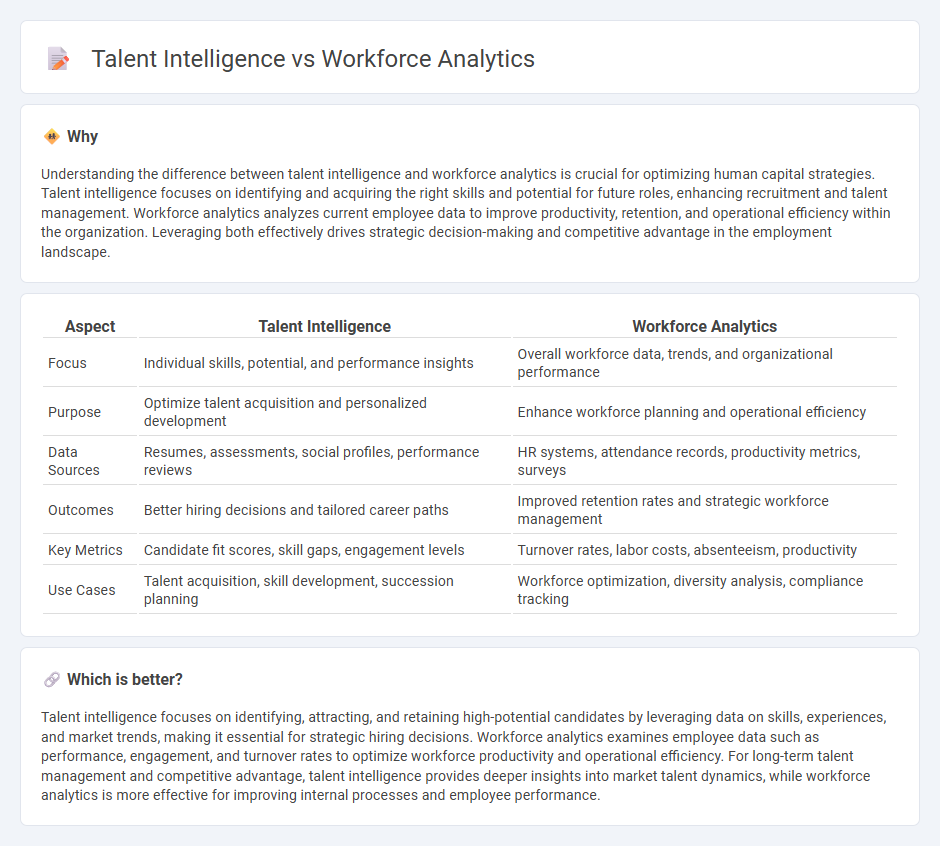
Talent intelligence harnesses external market data to identify and attract high-potential candidates, enhancing recruitment strategies and talent acquisition outcomes. Workforce analytics focuses on internal employee data, analyzing performance, retention, and engagement to optimize workforce management and productivity. Explore how integrating talent intelligence with workforce analytics can revolutionize your organization's employment strategy.
Why it is important
Understanding the difference between talent intelligence and workforce analytics is crucial for optimizing human capital strategies. Talent intelligence focuses on identifying and acquiring the right skills and potential for future roles, enhancing recruitment and talent management. Workforce analytics analyzes current employee data to improve productivity, retention, and operational efficiency within the organization. Leveraging both effectively drives strategic decision-making and competitive advantage in the employment landscape.
Comparison Table
| Aspect | Talent Intelligence | Workforce Analytics |
|---|---|---|
| Focus | Individual skills, potential, and performance insights | Overall workforce data, trends, and organizational performance |
| Purpose | Optimize talent acquisition and personalized development | Enhance workforce planning and operational efficiency |
| Data Sources | Resumes, assessments, social profiles, performance reviews | HR systems, attendance records, productivity metrics, surveys |
| Outcomes | Better hiring decisions and tailored career paths | Improved retention rates and strategic workforce management |
| Key Metrics | Candidate fit scores, skill gaps, engagement levels | Turnover rates, labor costs, absenteeism, productivity |
| Use Cases | Talent acquisition, skill development, succession planning | Workforce optimization, diversity analysis, compliance tracking |
Which is better?
Talent intelligence focuses on identifying, attracting, and retaining high-potential candidates by leveraging data on skills, experiences, and market trends, making it essential for strategic hiring decisions. Workforce analytics examines employee data such as performance, engagement, and turnover rates to optimize workforce productivity and operational efficiency. For long-term talent management and competitive advantage, talent intelligence provides deeper insights into market talent dynamics, while workforce analytics is more effective for improving internal processes and employee performance.
Connection
Talent intelligence leverages data on employee skills, performance, and market trends to inform strategic hiring and retention decisions. Workforce analytics processes this data to identify patterns and predict future workforce needs, enhancing organizational agility. The integration of these tools enables companies to optimize talent acquisition, development, and deployment for sustained competitive advantage.
Key Terms
Data-driven decision making
Workforce analytics leverages employee data to identify patterns and improve organizational performance through metrics like productivity, turnover rates, and employee engagement. Talent intelligence focuses on using external and internal labor market insights to predict talent needs, optimize sourcing, and enhance recruitment strategies. Explore how integrating workforce analytics with talent intelligence can elevate your data-driven decision-making processes.
Predictive modeling
Workforce analytics leverages predictive modeling to analyze historical employee data, uncovering trends that optimize workforce planning, reduce turnover, and enhance performance management. Talent intelligence applies predictive techniques to external and internal talent pools, identifying future skill needs and enabling proactive talent acquisition and development strategies. Explore how integrating predictive modeling in these fields empowers data-driven decision-making and strategic talent management.
Skills mapping
Workforce analytics primarily focuses on analyzing employee data to optimize performance, while talent intelligence emphasizes mapping skills to identify gaps and match candidates to roles effectively. Skills mapping in talent intelligence provides detailed insights into current competencies and future skill requirements, enabling strategic workforce planning. Explore how integrating skills mapping enhances talent acquisition and development strategies.
Source and External Links
Workforce Analytics: Examples and Best Practices - Lightcast - Workforce analytics uses data to measure and improve workforce performance, helping align HR strategies with business goals through insights across recruitment, retention, and skill forecasting, including predictive analytics for future workforce trends.
What Is Workforce Analytics? Your 2025 A-Z Guide - AIHR - Workforce analytics systematically uses data to inform HR decisions with descriptive, diagnostic, and predictive analyses that uncover trends, root causes, and forecast future workforce needs to optimize talent management.
Workforce Analytics: A Comprehensive Guide - ActivTrak - Workforce analytics collects and analyzes employee data from various work settings to enhance engagement, reduce burnout, and boost productivity by enabling data-driven decisions on employee experience and operational efficiency.
 dowidth.com
dowidth.com